- Knowledge Base

Account Category Reference (ACR) – Grandfather of Automatic Account Determination Process
- Created 2021-12-13
- Author SAP Online Tutorials
- Category SAP MM
Every movement of goods is followed by movement type only and without movement type use / without help of movement type – no goods movement is possible in SAP. During goods movement of transaction posting, movement type trigger transaction event key and G/L account assignment triggers based transaction event key (OBYC) with valuation class where valuation class determines the valuation class available in material master which is used for transaction posting. For automatic account determination, the vital direct parameters involves are movement type, valuation class, chart of account, valuation area, business key (transaction key), valuation grouping code{ valuation modification or valuation modifier}, account grouping code{general modification or general modifier },nature of G/L account ,posting keys and value string.
Moderately understandable, only large vital factor – valuation class in material master determine G/L account on goods movement for a movement type and then, all are happy on validation in/for business process by cross checking accounting entries in each case/stage. Essential regard to account category reference (which is very much responsible of having valuation class in material master), play grandparent role by being silent friend for success to automatic account determination process.
The account category reference (ACR) is an artificial code of four characters which allows flexibility in linking material type with valuation class. In reality, the valuation class is linked to an account category reference and account category reference linked to material type. In other term account category reference is used to simplify the assignment of permitted valuation class/valuation classes to the material type/ material types.
Business Case-1: How to use Account Category Reference
Based on requirement, business can have one material type, one account category reference and one valuation class by assigning material type to account category reference and then assigning account category reference to valuation class. For example business can have one custom material type ZROM (Raw Material) with custom account category reference (Z001) and new valuation class (3005) for Raw Material(Raw material – inventory managed with quantity and value)
During material creation with transaction code: MM01 with certain material type manually or by any uploading tool, only one permitted valuation class is defaulted for that material type by account category reference . So in material creation process no chance of making any mistakes by users or by any uploading tool.
Business Case-2: How to use Account Category Reference
Based on requirement, business can have one material type, one account category reference and multiple valuation classes by assigning material type to account category reference and then assigning account category to valuation classes. For example business can have one custom material type ZROM (Raw Material) with custom account category reference (Z001) and new valuation classes i.e. (3005) for Raw Material, (3006) for Chemicals and (3007) for Filter material (all materials are inventory manage with quantity and value)
During material creation with transaction code: MM01 with certain material type manually or by any uploading tool, only permitted valuation classes are defaulted for that material type by account category reference . Here, there is a chance of entering wrong valuation class by user manually or through upload file using a tool which needs to be validated.
Business can go for designing a custom transaction code where material can be created through uploading file which can be verified by central material creation officer.
Business Case-3: How to use Account Category Reference
Based on requirement, business can have multiple material types, one account category reference and multiple valuation classes by assigning material types to account category reference and then assigning account category reference to valuation classes. For example business can have three custom material types such as ZROM (Raw Material), ZCHE(Chemicals ) and ZFIL(Filter material ) with one custom account category reference (Z001) and three new valuation classes ie.. (3005) for Raw Material, (3006) for Chemicals and (3007) for Filter material (all materials are inventory manage with quantity and value)
During manual material creation with transaction code: MM01 or material creation by any uploading tool, only permitted valuation classes are defaulted for that material type by account category reference . Here, entering correct combination of material type for material and valuation class are expected through manually or through upload file which needs to be validated.
Business can go for designing a custom transaction code where material can be created by referring uploading file which can be verified by central material creation officer.
Also business can think of having “material master creation form” for any new material master creation, if necessary material code/ material number is not available in system – User/Users can fill the “template of uploading file’ with duly filled “material master creation form” and send for approval.On appropriate check and verification with approval from approving authority, if central material creation officer is happy, then he /she can upload file with custom transaction code for new material code.
http://scn.sap.com/thread/1748734
http://scn.sap.com/thread/2012467
http://scn.sap.com/thread/3158751
Before concluding, based on business scenarios and material behaves to business on purchasing, inventory management and accounting management – one can decide on usage of valuation class and material type permitted by account category reference.
Was this article helpful?
Related articles, leave a comment cancel reply.
You must be logged in to post a comment.

- SAP MM Tutorial
- SAP MM- Home
- SAP MM - Overview
- SAP MM - Screen Navigation
- SAP MM - Procurement Process
- SAP MM - Organization Structure
- SAP MM - Enterprise Structure
- SAP MM - Defining Structure
- SAP MM - Organizational Units
- SAP MM - Master Data
- SAP MM - Purchase Info Record
- SAP MM - Source Determination/List
- SAP MM - Procurement Cycle
- SAP MM - Purchase Requisition
- SAP MM - Request for Quotation
- SAP MM - Outline Agreement
- SAP MM - Quota Arrangement
- SAP MM - Posting Period
- SAP MM - Purchase Order Types
- SAP MM - Inventory Management
- SAP MM - Invoice Verification
- SAP MM - Service Management
- SAP MM - Valuation
SAP MM - Account Determination
- SAP MM - Configuration
- SAP MM - Transaction codes
- SAP MM Useful Resources
- SAP MM - Questions & Answers
- SAP MM - Quick Guide
- SAP MM - Useful Resources
- SAP MM - Discussion
- Selected Reading
- UPSC IAS Exams Notes
- Developer's Best Practices
- Questions and Answers
- Effective Resume Writing
- HR Interview Questions
- Computer Glossary
In SAP MM, procurement process involves the cost of goods and services that needs to be paid to the vendor by an organization. The cost being paid must be posted in an organization necessarily in a correct general ledger (G/L) account. It is quite impossible to recollect and feed the correct G/L account every time during procurement. To avoid this inconvenience, the SAP system can be configured so that the system will automatically determine the correct G/L account that needs to be posted. G/L account is posted when goods receipt is done as well as during clearing the invoice verification. Account determination deals with the following terms−
Define Valuation Control
- Group together Valuation Areas
Define Valuation Classes
Configure automatic posting.
Valuation areas can be grouped together and can be assigned to one grouping code, if they belong to the same G/L account. For example, different plants under one company code can be assigned the same valuation grouping code and vice versa. Before this, valuation grouping code must be activated and this can be done by following the steps given below.
Path to Activate Valuation Grouping Code
IMG ⇒ Materials Management ⇒ Valuation and Account Assignment ⇒ Account Determination ⇒ Account Determination without Wizard ⇒ Define Valuation Control
TCode: OMWM
Step 1 − On the Display IMG screen, select Define Valuation Control by following the above path.
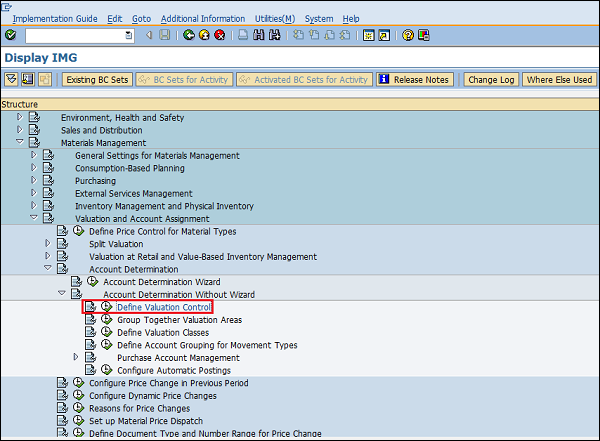
Step 2 − Select Valuation grouping code. Click on Save. Valuation grouping code is now activated.
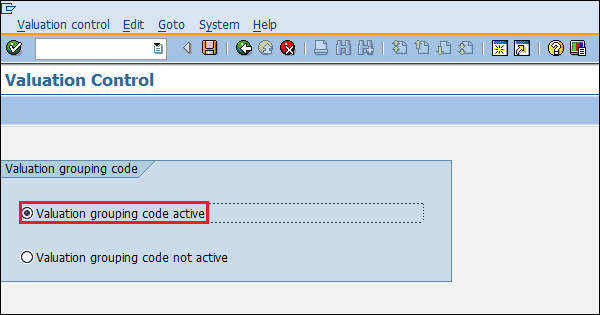
Group Together Valuation Areas
In valuation grouping, valuation area and valuation grouping code are assigned to the company code. This can be done by following the below steps.
Path to Define Valuation Area and Valuation Grouping Code
IMG ⇒ Materials Management ⇒ Valuation and Account Assignment ⇒ Account Determination ⇒ Account Determination without Wizard ⇒ Group Together Valuation Areas
TCode: OMWD
Step 1 − On the Display IMG screen, select Group Together Valuation Areas by following the above path.
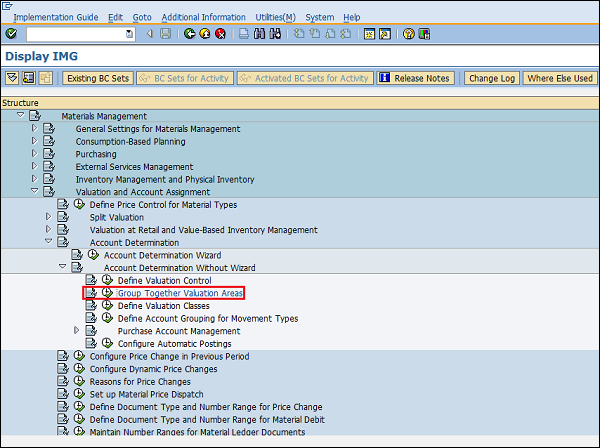
Step 2 − Here you can define a valuation area with grouping code, and assign them to a company code. Click on Save. Valuation area and valuation grouping code are now defined for a company code.
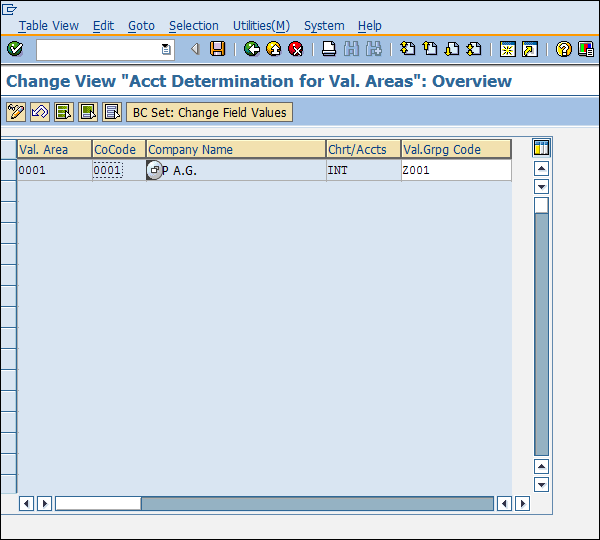
Valuation class categorizes the G/L account on the basis of material type. For example, raw material will have different G/L account than the finished material, as the costs will be different in both the cases. Account reference is also maintained along with the valuation class. Account reference and valuation class can be defined by following the steps given below.
Path to Define Account Reference and Valuation Class
IMG ⇒ Materials Management ⇒ Valuation and Account Assignment ⇒ Account Determination ⇒ Account Determination without Wizard ⇒ Define Valuation Classes
TCode: OMSK
Step 1 − On the Display IMG screen, select Define Valuation Classes by following the above path.
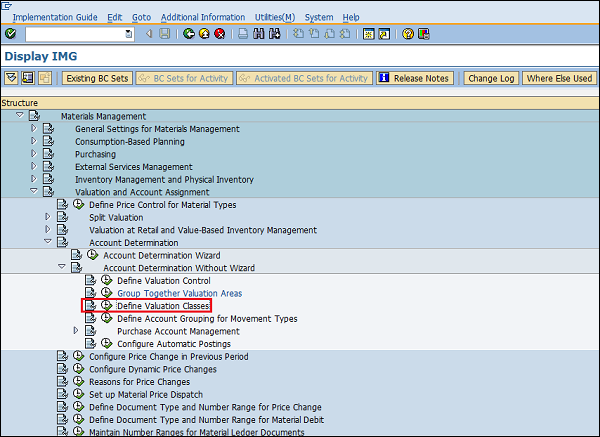
Step 2 − Click the Account Category Reference button.
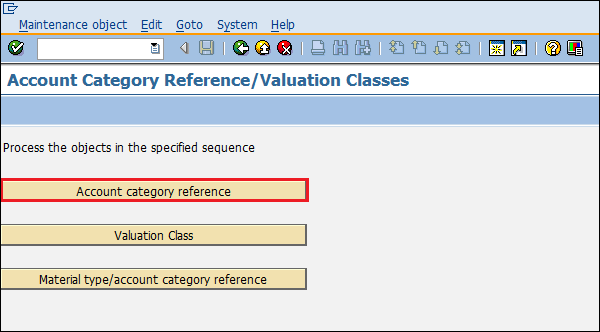
Step 3 − Click New Entries.
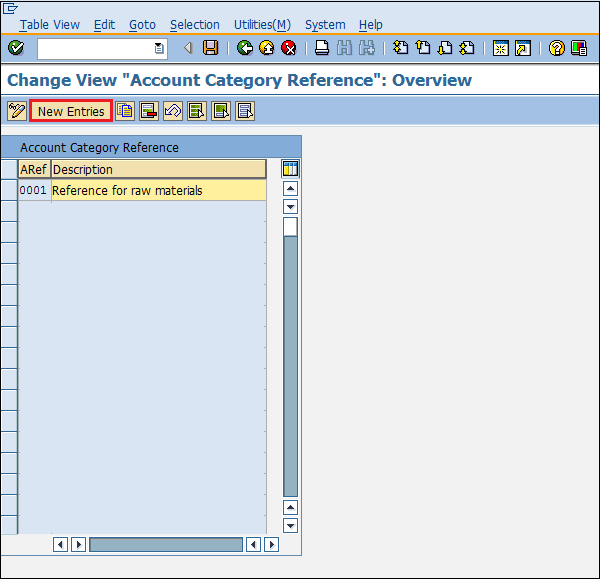
Step 4 − Provide the name of ARef (Account reference) along with its description.
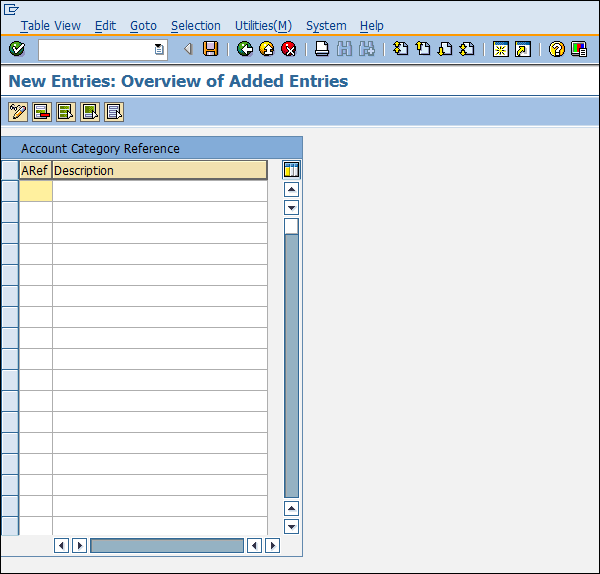
Step 5 − Now go to same screen and click Valuation Class.
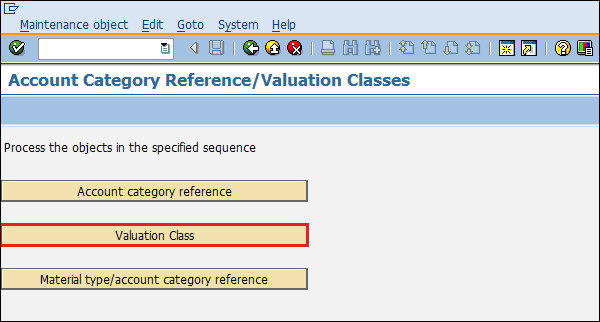
Step 6 − Click New Entries.
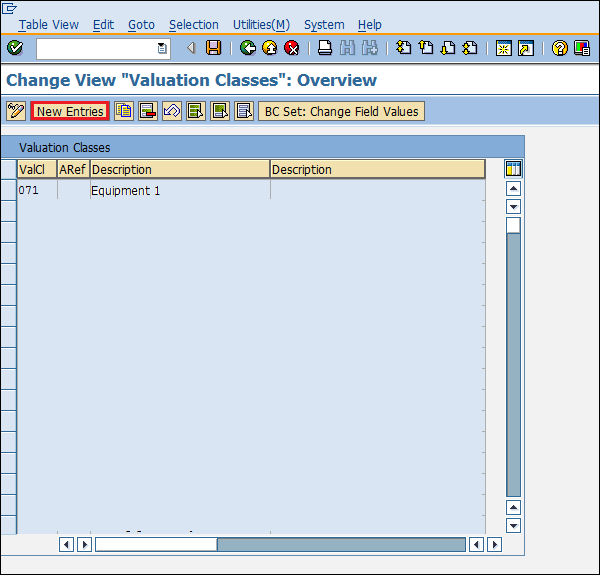
Step 7 − Provide the name of valuation class, ARef (Account reference), and description of valuation class.
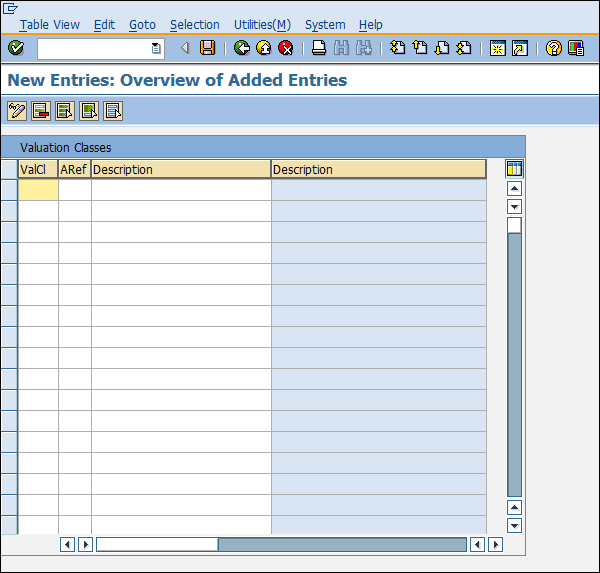
Step 8 − Now go to the same screen and click Material Type/Account Category Reference.
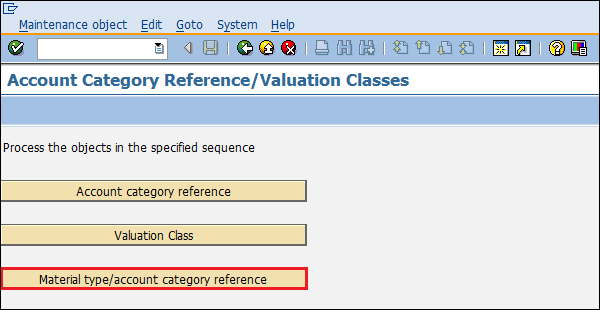
Step 9 − Here you can map material type with ARef (Account reference). Click on Save. G/L account can now be posted for different material types.
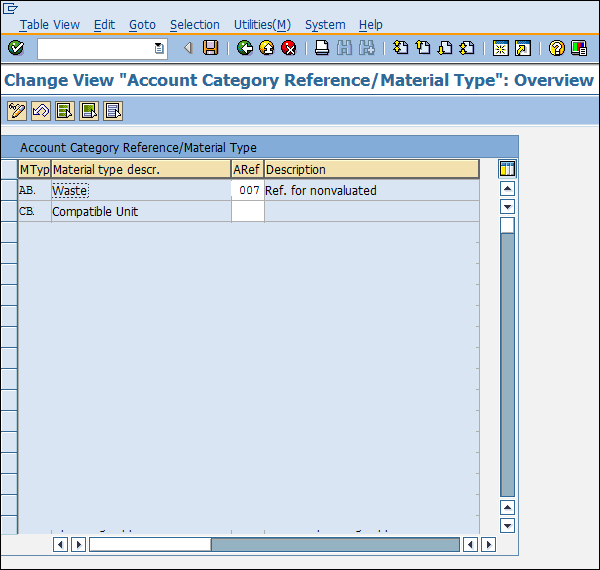
G/L account is automatically determined for each of the transactions. It happens so because automatic postings are configured in the SAP system. Automatic posting can be configured by following the steps given below.
Path to Configure Automatic Posting
IMG ⇒ Materials Management ⇒ Valuation and Account Assignment ⇒ Account Determination ⇒ Account Determination without Wizard ⇒ Configure Automatic Postings
TCode: OMWB
Step 1 − On the Display IMG screen, select Configure Automatic Postings by following the above path.
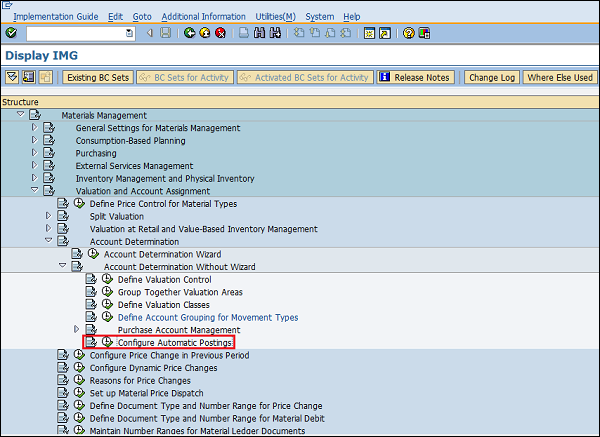
Step 2 − Click Account Assignment.
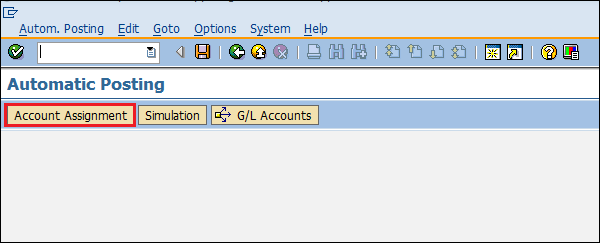
Step 3 − Here you can maintain the transaction for which automatic account determination is there. Click on Save. Automatic posting for transactions is now configured.
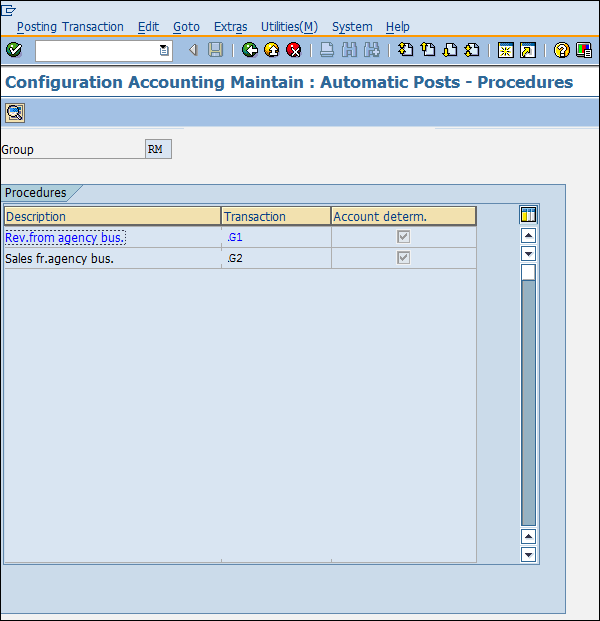
Valuation and Account Assignment In SAP MM

- Share this blog:
SAP MM valuation and Account Assignment
This is completely integrated with FI(Financial Accounting). material Valuation: stock value= stock Qty x Price. The material valuation will update the G/L accounts in Financial Accounting.
SAP MM valuation:
The procurement process begins with generating a purchase order plus ends with invoice verification. Within the entire process, one of the relevant parts is material Valuation. While developing purchase orders, material price is a necessary field plus it is automatically determined. It arises because material valuation is attested within the SAP system in the material master. Material valuation describes integration among MM & FI (Financial Accounting) modules as it updates the general ledger accounts within financial accounting. The important points to note regarding material Valuation are −
Material valuation assists in managing the price of the material.
Stock obtained from one vendor is valuated at a different price than the stock, which is obtained from the other vendor.
We can evaluate the material based on various types of Procurement which are called Split Valuation.
Split Valuation:
Split valuation assists in evaluating the stocks of materials within the same valuation area differently. Some of the examples where we use split valuations are:
A stock that is procured externally from a vendor has a distinct valuation price than the stock of in-house production.
Stock acquired from one vendor is valuated at a distinct price than the stock obtained from another vendor.
The same material possessing a different batch may maintain distinct valuation prices.
Split Valuation requires to be activated before setting any other configuration.
Valuation and Account Assignment :
- This is fully integrated with FI. Material Valuation: Stock value = Stock Qty X Price
- The material valuation will update the G/L accounts in Financial Accounting.
Material Valuation features:
- It allows you to evaluate the materials
- You can evaluate the materials differently based on sub stocks.
- It allows you to evaluate the balance sheet.
Material Valuation control:
This valuation is controllable by
- System settings (where valuation has to be done)
- Material master records (As a rule for each material has to be evaluated under a material type). If this material type is evaluated or not
For every material, you are assigning a valuation class.
- You are grouping a material type under the valuation class.
- All materials of a material type can have one material valuation class.
- Under a material type, you can have different valuation class for different materials
Materials under different material types can have the same valuation class.
Valuation structure:
Data over material is evaluated using the following structure
- Valuation area
- Valuation class
- Valuation category
- Valuation type
- Material type
- Movement type
Valuation area:
The valuation area is an Organizational level at which material valuation is done; the valuation area is defined as
Valuation area= company code
Complete stocks of that particular material in the company code are evaluated together
Valuation area= one plant
Valuation class:
We can group the different materials with the same properties into the valuation calls so that there is no need to control a separate stock account for each material.
All the materials with the same type are assigned to one valuation class.
Various materials with the same material type are assigned to different valuation classes.
Valuation category:
The criterion, according to which split Valuation is carried out:
Procurement: You can evaluate a material uniquely depending on whether it is made in-house or procured externally.
Origin: You can evaluate a material uniquely depending on where it comes from (such as home or else from abroad).
Status: You can evaluate a material uniquely depending on its status (such as new, used, or repaired).

Valuation Type:
The valuation type defines the unique character of the valuation category, like internal or external, within the case of Procurement. In the valuation category Origin, you can determine the different countries as the valuation types. You determine valuation types within Customizing. You first define all the correct valuation types for a valuation category.
You specify within this material master record that valuation types are permitted for a different material. For every material subject to split valuation, you must enter all the valuation types permitted within the material master record.
Material Type:
We can assign every material to a material type when we create it. Examples of material types in the standard system incorporate operating supplies, raw materials, and finished products.
Movement Type:
For every material movement, there is a movement type within the SAP System. The movement type manages the properties of the movement, for instance, which entries you have to make when entering a material movement, and which updates are taken out when the movement is posted.
Customization
SPRO -> Material Management -> Valuation and Account Assignment -> Define Price Control for Material Types
SPRO -> Material Management -> Valuation and Account Assignment -> Account Determination -> Account Determination Without Wizard
- Define Valuation Control (OMWM)
- Group Together Valuation Areas
- Define Valuation Classes
- Define Account Grouping for Movement Types (OMWN)
- Configure Automatic Postings
Define Valuation Control (OMWM):
Choosing the valuation level is one of the first steps we will perform while customizing the system.
If using the PP Production module, the valuation area must be set at the plant level. For account determination, you can group valuation areas by activating the valuation grouping code. This makes the configuration of automatic postings much easier.
Group Together Valuation Areas:
Valuation areas are grouped with the objective of simplifying the management of the standard accounts table by minimizing the number of entries.
Along with other factors, the valuation grouping code determines the G/L Accounts, to which a goods movement is posted (Automatic Account Determination).
The valuation grouping code makes it easier to set the automatic account determination.
Within the chart of accounts, we assigned the same valuation grouping code to the valuation areas.
Since we want to assign to the same G/L account, we assigned the same valuation grouping code to the valuation areas.
Define Valuation Classes:
The Valuation class is a group of material with the same G/L account.
When you create a material master record, you must assign the material to a valuation class. The valuation class is assigned to a material at the plant level. However, if using the split valuation, the valuation class will be assigned at the valuation type level.
The choices for valuation class are dependent on the material type. In general, several valuation classes can be allowed for one material type. Also, the same valuation class could be allowed for different material types.
The link between the valuation class and the material type is the account category reference. The account category reference is assigned to a material type.
The G/L account determined for the material is carried out according to the settings for its valuation class.
Step1: Account Category Reference: Account Category Reference (4 Char): Group of valuation classes that’s the system uses to check whether the valuation class you have entered is allowed when you maintain accounting data in a material master record.
Step2: Valuation Class: Here The Valuation Class is defined and an Account Category Reference is attached to a Valuation Class. Example: 3000 (Raw Materials) -> 0001 (Reference for Raw Materials)
Step3: Material Type / Account Category Reference: Here the Material Type can be assigned to an Account Category Reference. Example: ROH (Raw Materials) -> 0001 (Reference For Raw Materials)
Define Account Grouping for Movement Types: Movement type - Special stock indicator - Value updating - Quantity updating - Movement Indicator - Consumption posting - Posting string for values - Counter - Transaction/event key - Account modification - Check
The following diagram shows the relation between Chart of account, Transaction, account modifiers, accounts posting keys.
TRANSACTION / EVENT KEYS IN SAP
AUM: Stock transfers are there between plants and from one movement type to another with split valuation. The difference between the price at the delivery plant and the receiving point is booked at the latter.
Account to be opened: Loss – Stock Transfer Gain – Stock Transfer A/c
BO1: Check up Subsequent settlement of Provisions (e.g.: volume-based rebate)
BO2: Check up Subsequent settlement of revenues -conditions in inv. Verification
BO3: Check up Provision Differences
BSV: The Company sends materials for subcontract work, this transaction is considered, Accounts to be opened, Materials Consumed/Trading Goods w/o cost element, for ROH Inventory Change, Cost of Goods sold w/o Cost element, for FERT s
BSX: All stock postings to Stock Accounts due to Goods receipts & goods issues in Inventory Management. B/s Inventory A/c s 11101 to 11111
DIF: Small Differences that may arise during invoice verification in the invoice amount not exceeding tolerance.
Accounts to be opened: Loss—Inventory Differences A/c, Gain---Inventory Differences A/c
FRX: These are used for posting delivery costs when goods and invoices are received for purchase orders
FR1: Freight Clearing 69002 Separate A/c s is required
FR2: Provisions for freight Charges 69002
FR3: Customs Clearing 69002
FR4: Provisions for Customs Clearing
FRL: Services are performed for the company externally. Account to be opened: Purchased Services A/c
FRN: Services are performed for the company externally and hence delivery costs
Account to be opened: External Procurement Costs A/c
GBB: Offsetting Entries for Inventory Postings AUA For Order settlement 68005 (Factory output for Production)
AUF: For GRs for orders (w/o account assignment) 68005
BSA: For initial entry of stock balances 11199
INV: Expenditure/Income from Inventory differences 68004 – Raw Material Consumption A/c
VAX: For goods issues for sales orders with no assignment object The account will not be a cost element 68002 –Raw Material Indigenous 72001 – Stores & Spares
VAY: For goods issues for sales orders with assignment object The account is a cost element
VBO: Consumption from stock provided to vendor 68002 –Raw Material Indigenous
VBR: For internal goods issues (e.g.: to a cost center) 68005—Factory output for Production 72001 – Stores & Spares
VKA: For consumption in Sales Order without SD (Mvt. Type 231) 68005—Factory output for Production
VNG: For Scrapping & destruction 68004 – Raw Material Consumption – Others
VQY: For sampling with account assignment
ZOB: For goods issues with no Purchase order reference (Mvt 501)
ZOF: For goods issues with no production order reference (Mvt 521)
KBS: Account - assigned Purchase Order ie. account assignment taken from PO Account need not be assigned in OBYC
KDR: Exchange rate rounding differences in case of foreign currency invoices 80029 -- Exchange Rate Difference - Valuation 1
KDM: Exchange rate rounding differences for open items (invoice posting with a Different exch. rate than the GR/due to Std price difference/insufficient stock coverage) 80028 --Exchange Rate Difference - foreign currency to local
KDV: Material ledger from low levels E/R diff.
KON: Consignment payables
KTR: Offsetting entry for price differences in cost object hierarchies 68005—Factory output for Production
LKW: Accruals and deference. acct (material ledger)
PRD: Price Differences, Loss/Gain Inventory Differences (Two A/cs to be opened & assigned) 68004 – Raw Material Consumption – Others A/c is assigned
PRK: Price Differences in cost object hierarchies Loss/Gain Inventory Differences (Two A/cs to be opened & assigned)
RKA: Inv. reductions from logistic invoice verification
UMB: Gain/loss from revaluation Checkup- 68004 is found attached (Raw Material Consumption – Others A/c )
UPF: Unplanned delivery costs
VST: Input Tax
WGI: Goods issue inflation revaluation
WGR: Goods receipt inflation revaluation
WRX: GR/IR clearing account 40051 – GR/IR Clearing A/c
WRY: GR/IR clearing acct (mat. ledger) (old)
[Check Out: SAP MM Tutorial ]
Account assignment in SAP MM:
Account Assignment category is a very relevant field available and utilized in the purchasing documents. It has various control functions and assists in managing the objects (e.g. sales order, cost center, project) that are charged within the case of a purchase order for material that is meant for direct usage or consumption.
Use of account assignment:
You define which account assignment object is to be charged through the account assignment category such as (sales order, cost center, etc.,) Which accounts are to be charged. At the same time, the incoming invoice or else goods receipt is posted, and which account assignment data you have to give. The account assignment category is utilized at the time of the creation of a purchase order. For regular PO, no account assignment category is used.
Account assignment category:
The account assignment category defines:
The quality of the account assignment (sales order, cost center, and so on)
Which accounts are to be charged while the incoming invoice or goods receipt is posted.
Which account assignment data you have to provide.
Account assignment categories:
Conclusion :
A valuation modifier is used to let the system find the predefined posting rules discover how the accounts of the financial accounting system are to be posted and update the stock fields within the material master data. Whereas by using the account assignment, we can specify which object is to be charged through the account assignment.
You liked the article?
Vote for difficulty
Current difficulty (Avg): Medium
Recommended Articles
Embedded Systems Interview Questions Views 1547 Types of Pointers in C Views 14352 Oracle Procure To Pay Interview Questions Views 4352 Characteristics of C Language Views 10834 Salesforce Sample Triggers with different Scenarios Views 11712 Oracle Financials Interview Questions Views 9437
Recommended Courses
About author.
TekSlate is the best online training provider in delivering world-class IT skills to individuals and corporates from all parts of the globe. We are proven experts in accumulating every need of an IT skills upgrade aspirant and have delivered excellent services. We aim to bring you all the essentials to learn and master new technologies in the market with our articles, blogs, and videos. Build your career success with us, enhancing most in-demand skills in the market.
Stay Updated
Get stories of change makers and innovators from the startup ecosystem in your inbox
Related Blogs
SAP MM Tutorial
SAP MM Interview Questions
Enterprise Structure in SAP MM
Material Master Data in SAP MM
Vendor Master In SAP MM
Procurement Cycle In SAP MM
TutorialKart
Sap accountcategoryreference tables, top sap tables.
Giants designate once-touted prospect Joey Bart for assignment

SAN DIEGO -- Joey Bart , once considered the likely successor to Buster Posey as the San Francisco Giants ' catcher, was designated for assignment Sunday.
San Francisco made the move to open a roster spot for 28-year-old right-hander Daulton Jefferies, who started against San Diego in his first major league appearance since May 18, 2022, with Oakland.
Now 27, Bart was selected by the Giants with the No. 2 pick in the 2018 amateur draft. Bart played in 162 games over four seasons with San Francisco, hitting .219 in 457 at-bats with 11 homers, 38 RBIs and 178 strikeouts.
San Francisco had been carrying two other catchers in addition to Bart: Patrick Bailey and Tom Murphy .
Jefferies' contract was selected from Triple-A Sacramento.
Related Topics
- SAN FRANCISCO-GIANTS
Top Stories

Man hospitalized after shooting in downtown Fresno, police say

$20 minimum wage kicks in for fast food workers in California
- 2 hours ago

Isolated travelers escorted past Big Sur road collapse

Pondexter says he was 'not granted interview' with FS Men's basketball
- 15 minutes ago

Crews work to open temporary channel near Baltimore bridge collapse
- 3 hours ago
Woman hospitalized after hit-and-run in Visalia, police say
- 37 minutes ago
Hundreds gather at Fresno's Woodward Park for Easter celebrations
Man walking in central Fresno struck by stray bullet, police say
Account Assignment Category
Technical name: 0BBP_ACCCAT
The account assignment category determines the account assignment element (for example, cost center or WBS element) to be supplied.
Technical data

IMAGES
VIDEO
COMMENTS
Account Assignment Category: It indicates what type of purchase the company is doing in Purchasing Documents, whether it is for consumption or anything relation to orders, projects etc. The nature of this also indicates which accounts it needs to be charged for when the incoming invoice and Goods Receipt are posted. Path.
In reality, the valuation class is linked to an account category reference and account category reference linked to material type. In other term account category reference is used to simplify the assignment of permitted valuation class/valuation classes to the material type/ material types. Business Case-1: How to use Account Category Reference
Click on Account Category Reference and, if needed, create an account category reference, as shown here: Click on Valuation Class, shown below, and then click on the New Entries Create a new valuation class (ValCl) 3004 (with Description Raw Materials- Steel) and assign the valuation class to account category reference (ARef) 0001. 2
The link between the valuation classes and the material types is set up via the account category reference. The account category reference is a combination of valuation classes. Precisely one account category reference is assigned to a material type. Example. Requirements. You must have defined your material types. You must have defined the ...
How to create valuation class|| Valuation class assignment with account category reference|| Details of Moving average price and Standard Price. Valuation c...
Step 1 − On the Display IMG screen, select Define Valuation Classes by following the above path. Step 2 − Click the Account Category Reference button. Step 3 − Click New Entries. Step 4 − Provide the name of ARef (Account reference) along with its description. Step 5 − Now go to same screen and click Valuation Class.
Step1: Account Category Reference: ... Account Assignment category is a very relevant field available and utilized in the purchasing documents. It has various control functions and assists in managing the objects (e.g. sales order, cost center, project) that are charged within the case of a purchase order for material that is meant for direct ...
Creating an Account Category Override by DOI or Owner | SAP Help Portal. Relevancy Factor: 30.0. Use this to override the usual Account Category search method, instead indicating an override account that you would like the system to use. This is used to override the usual account assignment for a specific owner/DOI, etc.
The account assignment category determines: The nature of the account assignment (cost center, sales order, and so on) Which accounts are to be charged when the incoming invoice or goods receipt is posted. Which account assignment data you must provide. Account Assignment Categories. Description. Required account assignment data.
Material Table. Miro Table. SAP Account Category Reference Tables : T025K - Account Category Reference Tcode, TBKK43 - Reference Account Category Tcode, ACCASSTYPE00 - Account Assignment Category Tcode, ACCASSTYPE0C - Account Assignment Category Tcode, ACCASSTYPE0T - Account Assignment Category Tcode.
The permissible valuation classes depend on the material type. You establish the relationship between valuation classes and material types with the aid of the account category reference. The account category references are assigned to the material types. You can assign only one account category reference per material type. It has to be A ...
Availability of Performance Function. Position Flow List. Posting Journal. Reversal of Account Assignment Reference Transfer. General Selections. Example: Valuation and Transfer not Affecting Net Income. Example: Exercise of a Put Warrant with Delivery. Initialization of Parallel Position Management. Product Groups.
Internal Classification of Billing account category Fields. FI - Billing in Contract Accounts Receivable and Payable. Structure. 61. FMCA_XML_DOM_MAPPING. BRF: XML Document and Contract account category Assignment. IS - Public Sector Contract Accounts Receivable and Payable. Structure. 62.
The Office of Management and Budget announced Thursday changes to how the federal government asks about people's race and ethnicity, including in the US Census.
The following account assignment categories are available: Asset. Cost center. Network. Order. Sales order. WBS element. Unknown. In the SAP back-end system the account assignment category is part of the item data, whereas in SAP SRM the account assignment category is managed at account level. Modifiable texts for account assignment categories
SAN DIEGO -- Joey Bart, once considered the likely successor to Buster Posey as the San Francisco Giants' catcher, was designated for assignment on Sunday. San Francisco made the move to open a ...
Answers (2) 12-01-2009. 10-24-2009. Account Assignment category is one of the very important fields available and used in the purchasing documents. It has many control functions and helps in determining the object that will be charged in case of an ordered material which is procured for direct usage or consumption.
The account assignment category determines the account assignment element (for example, cost center or WBS element) to be supplied. Technical data. Available from Release. 2.0B (SAP B2B Procurement) Data element. ACC_CAT . Reference characteristic ...